Solar Eclipses of History
Norma Reis
| Index |
| Introduction |
| Part 1: Solar Eclipses of Ancient Times |
| Part 2: Solar Eclipses of the Middle Ages |
| Part 3: Solar Eclipses of the Modern Era |
Introduction
Since the very beginning of history, people have been amazed by what they see when they look up at the sky. Indeed, looking at the celestial sphere without the unpleasant interference of city lights is magnificent. It can sometimes mesmerise us with a deep desire of traveling out to these celestial spheres to directly experience what our eyes cannot see. Human imagination has no boundaries, but the universe is infinite! However, most ancient civilizations have viewed changes in the sky with great fear and apprehension. Comets, meteor showers, supernovae, lunar and solar eclipses were viewed as bad omens by most societies.
The Sun and the Moon are the main actors in the celestial theatre, the former being vital for life on Earth. The Moon, by its turn, has served as special inspiration for poets, writers, and lovers. The Sun and Moon have also been associated with religion and mythology, and sometimes regarded as gods with influence on the destiny of both societies and individuals.
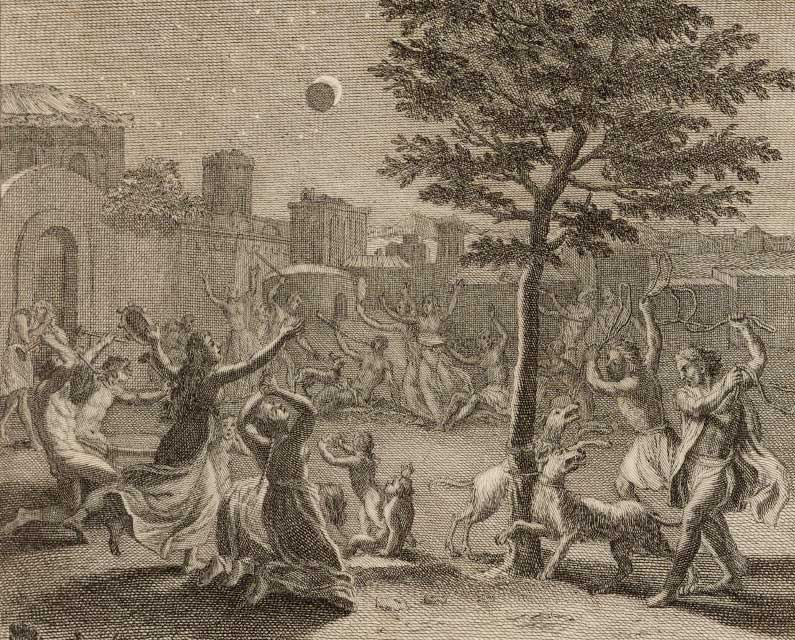
"Desolation des Peruviens pendant L'Eclipse de Lune. Voyage Historique de l’Amerique Meridionale."
The Spanish explorer Don Juan described the Peruvians' despair during an eclipse.
Source: The Philadelphia Print Shop Ltd.
Solar and lunar eclipses were usually regarded as a disturbance in the natural order of the sky - as an indication that something was going wrong. Many historical events coincided with solar or lunar eclipses: battles, crowning or dethroning of emperors, peace treaties, and so forth. It is our nature as human beings to attribute meaning to events by whatever history, tradition or thought is available to us. The same is true for eclipses throughout the centuries.
Unlike comets, which for a long time were regarded as unpredictable events, eclipses were accurately predicted at the earliest stages of mankind's history. Early astronomers were able to predict eclipses by around 2300 BCE. Their predictions were based on empirical relationships, governing the recurrence of events by which the relative positions of the Earth, Sun and Moon reoccur the same way after 6,585 days. The existence of a regular eclipse cycle, such as the Saros cycle, resulted from these coincidences involving complex combinations between the movements of the Moon, Earth, and Sun. This more detailed knowledge of eclipses started to be acquired during the second century BCE, the golden age of Greek astronomy.
But the general population did not understand these relationships. As governors began to realize the influence astronomical phenomena exerted over the population, they used this knowledge as an instrument of power to influence people's psyche. The population would follow rituals and say prayers in order to prevent the supposed dire effects. Governors wanted to pretend they could influence the obscure powers involved, and likewise, astrologers and astronomers sometimes attempted to use their knowledge to manipulate and influence governors. A negative or positive correlation with an eclipse could affect the outcome of a battle.
Only in the last five hundred years or so, or certainly since the invention of the telescope in 1609, have we come to understand these cosmic concurrences primarily in terms of the natural order of the universe. As previously mentioned, these events are no longer feared, but viewed as singular opportunities to better understand the universe. In this article, we present some important solar and lunar eclipses throughout time and their impact on people, societies, and science.
This page focuses on Solar Eclipses of History. At the conclusion of each historical eclipse description is a link to a map and detailed predictions for the eclipse. A companion article covers Lunar Eclipses of History.
The Catalog of Solar Eclipses of Historical Interest contains many more examples of important eclipses that have left their mark on history.
Of related interest are the Catalog of Lunar Eclipses of Historical Interest and the Catalog of Solar Eclipses of Historical Interest.
Part 1: Solar Eclipses of Ancient Times
Ho and Hi, the Drunk Astronomers (2137 BCE)
Throughout the centuries, Chinese astronomers devoted substantial efforts towards predicting eclipses. However, like all similar efforts prior to the Renaissance, this could only be by empirical research. The earliest record of a solar eclipse comes from ancient Chinese history. Identifications of this event have varied from 2165 – 1948 BCE, though the favoured date is October 22, 2137 BCE. Ancient Chinese astronomy was primarily a governmental activity. It was the astronomer's role to keep track of solar, lunar and planetary motions and explain what they meant to the ruling emperor.

Eclipse observation in China around 1840.
Astronomers calmly observe an eclipse and the servants, terrified, prostrate themselves on the ground to placate the bad omen.
Credit: History of China and India © Mary Evans / Explorer.
Source: Brunier and Luminet, Glorious Eclipses, Cambridge University Press.
According to legend, the royal astronomers Ho and Hi dedicated too much of their time to consuming alcohol and failed to predict a forthcoming eclipse. Traditionally, the solar eclipse recorded in the Shu Ching (an historical classic text) was regarded as having occured the 3rd millennium BCE. On the first day of the month, in the last month of autumn, the Sun and the Moon did not meet (harmoniously) in Fang' ... so runs the text. The emperor became very unhappy because, without knowing that there was an eclipse coming, he was unable to organize teams to beat drums and shoot arrows in the air to frighten away the invisible dragon. The Sun did survive, but the two astronomers lost their heads for such negligence. Since then, a legend arose that no one has ever seen an astronomer drunk during an eclipse.
"Here lie the bodies of Ho and Hi
Whose fate though sad was visible,
Being hanged because they could not spy
Th’eclipse which was invisible."
- Author unknown
Eclipse of Abraham in Canaan (1533 BCE)
Eclipses are also mentioned in sacred books such as the Bible. One of the best-known references to eclipses appears in the book of Genesis, which involves the journey of Abraham into Canaan:
"And when the Sun was going down ... great darkness fell upon him."
It is possible to relate this description with a computed solar eclipse occurring on May 9, 1533 BCE.
Map and eclipse predictions: Total Solar Eclipse of -1532 May 10

Abraham journeying into Canaan.
This image was produced by the French artist Gustave Dore and illustrates the journey into Canaan.
Homecoming of Odysseus (1178 BCE)
There is some evidence to suggest that Odysseus, from Homer's Odyssey, could have returned to his Penelope on the day of an eclipse. Basically, we have three cases of evidence for this hypothesis:
a) Plutharch interpreted a passage in the 20th book of that masterpiece of literature to be a poetic description of a total solar eclipse at Odysseus' return;
b) A century ago, astronomers estimated that such an eclipse occurred over the Greek islands on April 16, 1178 BCE, the only one in the region close to the estimated date of the fall of Troy;
c) Recently, astronomical references led two scientists to state that the total solar eclipse of 1178 coincided with the homecoming of Odysseus to rejoin Penelope after the Trojan War.
Almost all classic scholars are skeptical of this correlation. If there was an eclipse, Homer must have had it in mind when he wrote of a seer prophesying the death of Penelope's waiting suitors and their entrance into Hades. The story does not mention an eclipse, but there are omens and a poetic description of a total solar eclipse. Odysseus arrived home, disguised in beggar's rags and in hiding before revealing himself. It happens that, when Penelope's persistent suitors sat down at noon for a meal, they started laughing and saw their food spattered with blood. At this moment, the seer Theoclymenus foretells their death, ending with the sentence, "The Sun has been obliterated from the sky, and an unlucky darkness invades the world." This description suggests a solar eclipse over Ithaca. As a matter of fact, Odysseus killed Penelope's suitors who wanted to steal his throne and afterwards he spent a long night of love with his wife.
Map and eclipse predictions: Total Solar Eclipse of -1177 Apr 16
The Old Testament Eclipse (763 BCE)
One passage in the Bible says: "And on that day, says the Lord God, 'I will make the Sun go down at noon, and darken the Earth in broad daylight'". The corresponding eclipse should have occurred on June 15, 763 BCE. A cross-reference is provided by an Assyrian historical chronicle known as the Eponym Canon. In Assyria, each year was named after a ruling official and the year's events were recorded under that name in the Canon. Under the year corresponding to 763 BCE, a scribe at Nineveh wrote this simple line: "Insurrection in the City of Assur. In the month of Sivan, the Sun was eclipsed." Historians have thus been able to use this eclipse to improve the chronology of early biblical times.
Map and eclipse predictions: Total Solar Eclipse of -0762 Jun 15
Archilochus Eclipse (648 BCE)
It is believed that the Greek lyric poet Archilochus saw a total solar eclipse, which happened on April 6, 648 BCE: "Nothing there is beyond hope, nothing that can be sworn impossible, nothing wonderful, since Zeus father of the Olympians made night from midday, hiding the light of the shining sun, and sore fear came upon men."
Map and eclipse predictions: Total Solar Eclipse of -0647 Apr 06
Thales Eclipse (585 BCE)
In the West, the first prediction of a solar eclipse is associated with the Greek philosopher Thales of Miletus who, according to Herodotus, foretold the eclipse of 585 BCE, in Turkey:
"In the sixth year a battle took place in which it happened, when the fight had begun, that suddenly the day became night. And this change of the day Thales the Milesian had foretold to the Ionians laying down as a limit this very year in which the change took place. The Lydians however and the Medes, when they saw that it had become night instead of day, ceased from their fighting and were much more eager both of them that peace should be made between them."

Thales Eclipse.
The battle between the Lydians and Medes was arrested by the total eclipse of the Sun on May 28, 585 BCE (-584 May 28).
Although some argue that Thales used the Babylonian Saros period of 223 lunations it is now agreed by historians that the Saros period was not discovered before the fifth or fourth century BCE, therefore Thales could not have used that time system. There is a legend referring to the final battle of a fifteen-year war between the Lydians and the Medes, with ups and downs on both sides, but no decisive victory for either.
Also known as the "Battle of the Eclipse", it occurred at the Halys River on May 28, 585 BCE, and was suddenly terminated due to a total solar eclipse, which was perceived as an omen indicating that the Gods wanted the fighting to stop. The kings were impressed and stopped fighting. Since the exact dates of eclipses can be calculated, this battle is the earliest historical event for which a precise date is known. It is said that Thales was proclaimed a wise man by the oracle of Delphi in 582 BCE, possibly due to the eclipse prediction credited to him. However, it is clear that he did not understand the scientific basis of the phenomenon.
Map and eclipse predictions: Total Solar Eclipse of -0584 May 28
The Crucifixion Eclipse (29-33 CE)
According to the evangelists, Jesus was crucified on a Friday afternoon, some hours prior to the beginning of the Jewish Sabbath. It is recorded that Jesus was crucified during the period when Pontius Pilate was procurator of Judea (26-36 CE). However, there is no consensus on the date of the crucifixion. Evidence suggests April 3, 33 CE, while others suggest it was April 7, 30 CE. There are various allusions in the Bible to the Moon being dark and turned to blood when it rose in the evening after the crucifixion, which sounds like a lunar eclipse.
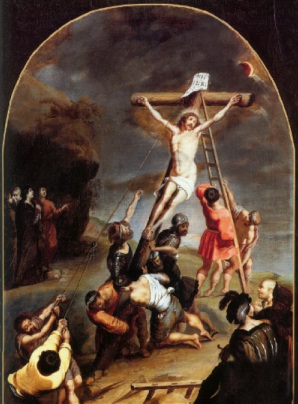
The crucifixion eclipse. According to the evangelists, the sun darkened during the crucifixion of Christ.
Later, the event was associated with an eclipse that was visible at Jerusalem.
Credit: © Valenciennes, Musee des Beaux Arts, photo R.G. Ojeda.
In Acts of the Apostles, Peter also refers to a Moon that is the colour of blood and a darkened sky. There is other evidence that on that day the Moon appeared like blood. The so-called Report of Pilate, a New Testament Apocryphal fragment, states:
"Jesus was delivered to him by Herod, Archelaus, Philip, Annas, Caiphas, and all the people. At his crucifixion the Sun was darkened; the stars appeared and in all the world people lighted lamps from the sixth hour till evening; the Moon appeared like blood."
This may be the result of a dust storm caused by the khamsin, a hot wind from the south. Under such circumstances - a lunar eclipse while there is much suspended dust - one would expect the Moon to appear the dark crimson of blood. The reason why the Moon is blood red is that, although it is geometrically in the Earth's shadow, sunlight is refracted through the Earth's upper atmosphere, where normal scattering will prevent blue light from penetrating. But this refracted light would be much weaker than direct light from even a small portion of the Sun and the blood colour associated with the eclipse would not be visible to the unaided eye. However, the Moon would have an amber colour from atmospheric absorption, similar to any other occasion when the Moon is low in the horizon.
Another hypothesis is that of a solar eclipse visible at Jerusalem on November 24, 29 CE. The Greek historian Phlegon mentions this eclipse in his History of the Olympiads, and says that it was accompanied by an earthquake. The Greek writer Phlegon reported that:
"In the fourth year of the 202nd Olympiad, there was an eclipse of the Sun which was greater than any known before and in the sixth hour of the day it became night; so that stars appeared in the heaven; and a great Earthquake that broke out in Bithynia destroyed the greatest part of Nicaea."
In fact, mention is also made in the Bible of the Sun being darkened earlier that day: "The Sun shall be turned into darkness."
There is controversy among researchers whether this was a solar or a lunar eclipse, and also controversy about the date. In any case, an eclipse occurring in the very same night of the crucifixion would have been seen by believers as a supernatural sign and influenced the change of mind of the Jews and Pilate towards the body of Christ, leading to the placing of a military guard on the tomb.
Map and eclipse predictions: Total Solar Eclipse of 0029 Nov 24
Part 2: Solar Eclipses of the Middle Ages
Muhammad's Eclipse (632 CE)
The founder of Islam, the prophet Muhammad, was born in Mecca in the Year of the Elephant, CE 569-570. His birth year got its name from an invasion by the Abyssinians, who used elephants in the assault. The army was driven off when birds dropped stones on the troops, causing an epidemic similar to smallpox. The Year of the Elephant was also memorable because of its solar eclipse.
In ancient times, births and deaths of leaders were correlated to celestial omens. However, Islamic theology does not accept that the eclipse was sent by God as an omen of the prophet’s birth, a doctrine that is based on another solar eclipse closely tied to Muhammad. His infant son Ibrahim died tragically on January 27, 632 CE. The Sun was eclipsed that day, and some Meccans said it was a sign from God. Muhammad, though, said "The Sun and Moon are signs of God and do not eclipse for the death or birth of any man."
Another solar eclipse related to Muhammad occurred 39 years after his death. In 661 CE, Mu'awiyah became leader of the empire after a revolt against Ali, the son of Muhammad's chief Meccan enemy. Mu'awiyah decided to transfer the prophet's pulpit from Medina to his capital in Damascus, Syria, but as his men were removing it, the sky darkened and stars were visible. It was considered a sign of divine anger, and the relic remained in Medina as a symbol of Mu'awiyah's failure.
Map and eclipse predictions:
Annular Solar Eclipse of 0632 Jan 27
Map and eclipse predictions:
Annular Solar Eclipse of 0661 Jul 02
Solar Eclipse of the Emperor Louis (840 CE)
Louis of Bavaria, the son of Charlemagne, was head of a great empire when, on May 5, 840 CE, he witnessed a solar eclipse. He was so petrified that he died just afterwards. His three sons then began to dispute his succession. Their quarrel was settled three years later with the Treaty of Verdun, dividing Europe into three large areas, namely France, Germany and Italy.
Map and eclipse predictions: Total Solar Eclipse of 0840 May 05
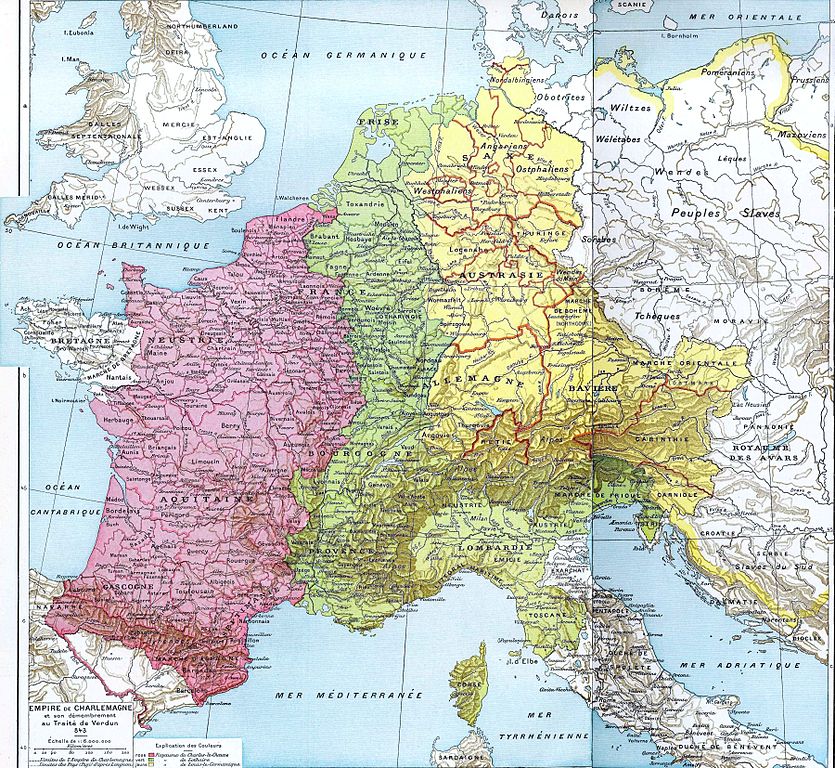
The Treaty of Verdun divided Europe into three major regions.
King Henry's Eclipse (1133 CE)
Visible in England and Germany, this total solar eclipse happened on August 2, 1133 CE, and prompted many descriptions in the chronicles of both countries. For the English, the eclipse occurred the day after the departure of King Henry I, being interpreted as an omen of his death. In fact, the king died shortly afterwards in Normandy, which subsequently confirmed the superstition. As for the Germans, they associated the darkening of the Sun to the sack of the city of Augsburg and the massacre of its inhabitants by Duke Frederick.
Map and eclipse predictions: Total Solar Eclipse of 1133 Aug 02

King Henry the First
The Black Hour (1433 CE)
One of the most celebrated eclipses in the Middle Ages was called the "Black Hour". It happened in Scotland and it has been said that darkness came about 3 pm on June 17, 1433 CE, and was very deep.
Map and eclipse predictions: Total Solar Eclipse of 1433 Jun 17
Part 3: Solar Eclipses of the Modern Era
Edmond Halley's Eclipse (1715 CE)
A few seconds before the Sun was all hid, there discovered itself round the Moon a luminous ring about a digit, or perhaps a tenth part of the Moon's diameter, in breadth. It was of a pale whiteness, or rather pearl-color, seeming to me a little tinged with the colors of the iris, and to be concentric with the Moon.
- Edmond Halley

Edmond Halley's Eclipse
Edmond Halley used Isaac Newton’s universal theory of gravitation to create several eclipse maps of very high accuracy.
Observational reports of the 1715 eclipse and allowed Halley to produce another map containing refinements to the paths of the 1715 eclipse along with the forthcoming 1724 eclipse.
Above was the description of the British astronomer Halley (1656-1742) for the solar corona during the total eclipse of May 3, 1715 CE, which was visible in England and Wales. Halley thought that he had seen the Moon's atmosphere for the first time! He became famous for discovering the periodicity of certain comets and predicting their return 76 years after the one he had observed in 1682. Basing his calculations on the law of universal attraction established by Newton, he provided the first physical explanation for the appearance of these wandering bodies that had previously terrified people.
Map and eclipse predictions: Total Solar Eclipse of 1715 May 03
Total Solar Eclipse of Louis XV (1724 CE)
The last total eclipse of the Sun visible in Paris occurred on May 22, 1724 CE. The young King Louis XV, at the time fourteen years old, observed it. The path of its shadow, very similar to the eclipse of August 11, 1999 CE, shifted southwards, and crossed England, France and Germany. It was carefully calculated and mapped, and painters depicted scenes of the crowds of spectators.
Map and eclipse predictions: Total Solar Eclipse of 1724 May 22
Nat Turner's Eclipse (1831 CE)
The greatest slave revolt in North America was led by Nat Turner (1800-1831). The clever Turner learned how to read with his master's son – an undesirable skill from the masters' viewpoint for a slave during these times due to fear of rebellion. Turner, afterwards, dedicated himself to religion and became a preacher for his followers (Schaefer, 1994). In 1828, he had a vision: he would lead his people to liberty, but he should wait for a sign from God – and it came from the sky.
An annular eclipse of the Sun occurred on February 12, 1831. Turner saw it as a 'black angel' occulting a white one – the time had arrived for blacks to overcome whites, so it was the right moment for rebellion. Several months later, after having murdered his original masters, Turner and his band of insurgents headed for the small town of Jerusalem where militiamen promptly interrupted their march. Most of the slaves, including Turner, went into hiding for seventy days before being taken to the gallows and hanged. Many people died in this revolt, and in no other episode have so many slave owners perished, a reason why many consider Turner to be a hero of the resistance to oppression against black people in the United States.
Map and eclipse predictions: Annular Solar Eclipse of 1831 Feb 12
Adams' Eclipse (1851 CE)
The total solar eclipse of July 28, 1851 CE, was the first subject of an eclipse expedition. The total phase was visible in Norway and Sweden, and many astronomers from all parts of Europe traveled to those countries to see the eclipse. Red flames were in evidence, and the fact that they belonged to the Sun and not to the Moon was clearly established.
The first photograph of the solar corona was taken during this solar eclipse and the best observations were made in Scandinavia. Edwin Dunkin wrote:
The prominences were clearly visible, especially a large hooked protuberance. This remarkable stream of hydrogen gas, rendered incandescent while passing through the heated photosphere of the Sun, attracted the attention of nearly all the observers at the different stations.
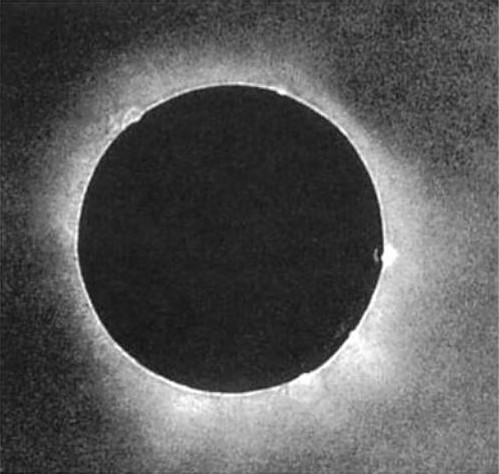
Daguerreotype of 1851 Total Solar Eclipse
Berkowski made this first solar eclipse photograph at the Royal Observatory in Königsberg, Prussia (now Kalinigrad, Russia).
The best account comes from the great astronomer, John Couch Adams. In 1845, Adams calculated, at the same time as the Frenchman Le Verrier, the position of Neptune. At this time in history, many astronomers had never observed a total eclipse, because they rarely occurred at any given place, and transport facilities were few and far between. In his article that appeared in the Memoirs of the Royal Astronomical Society, Adams' lyrical style conveys the extraordinary emotion of an experienced astronomer who realizes that he is a complete novice in seeing this spectacle for the first time:
The approach of the total eclipse of July 28, 1851, produced in me a strong desire to witness so rare and striking a phenomenon. Not that I had much hope of being able to add anything of scientific importance to the accounts of the many experienced astronomers who were preparing to observe it; for I was not unaware of the difficulty which one not much accustomed to astronomical observation would have in preserving the requisite coolness and command of the attention amid circumstances so novel, where the points of interest are so numerous, and the time allowed for observation is so short.
Adams then describes the magical appearance of the corona:
The appearance of the corona, shining with a cold unEarthly light, made an impression on my mind which can never be effaced, and an involuntary feeling of loneliness and disquietude came upon me… A party of haymakers, who had been laughing and chatting merrily at their work during the early part of the eclipse, were now seated on the ground, in a group near the telescope, watching what was taking place with the greatest interest, and preserving a profound silence… A crow was the only animal near me; it seemed quite bewildered, croaking and flying backwards and forwards near the ground in an uncertain manner.
In another written piece, he compares the corona with the luminous halo that painters draw around the heads of saints.
Map and eclipse predictions: Total Solar Eclipse of 1851 Jul 28
General Gordon and Fatal Eclipses (1863 and 1885 CE)
An ancient Chinese aphorism says that every dynasty starts with the replacement of an old, degenerate regime ruled by corruption and ineffectiveness. But as time goes by, new governors, in principle virtuous, come into the same vices and the so-called "Mandate of Heaven" (as they reign by divine gift) is passed on. In such a society, signs of the sky can greatly influence politics. The Ch'ing dynasty began in 1644, and achieved great splendor. By the mid-19th century, however, it started to become ineffective and corrupt. At this time, the British general Charles Gordon was charged by the western powers to help the Emperor of China and his dynasty in their fight against the Taiping revolt. Skilled with military genius and leadership, Gordon commanded an army of Chinese mercenaries and had many victories.
On November 25, 1863 CE, a partial lunar eclipse frightened his troops during the siege of Soochow (Suzhou) in Kiangsu (Jiangsu). The superstitious Chinese interpreted the event as a bad omen for the Emperor. Soochow was not conquered and the Taiping revolt was settled peacefully. The effect of this eclipse can thus be seen as a cause of General Gordon's first defeat. Another eclipse - solar this time - on March 16, was directly responsible for his death. In 1886, he was in charge of the defense of Khartoum, the capital of the Sudan, under attack by a charismatic religious leader, the Mahdi. A solar eclipse demoralized Gordon's troops. The city was taken before British troops could arrive with reinforcements and the British general did not survive the massacre.
Map and eclipse predictions:
Partial Lunar Eclipse of 1863 Nov 25
Map and eclipse predictions:
Total Solar Eclipse of 1886 Aug 29
The Great Eclipse of 1878
The Moon's shadow took some 20 minutes to cross Wyoming and Colorado, in the United States, on July 29, 1878. Considered one of the greatest eclipse events of that century, it is known as the great eclipse of 1878 for its large path of visibility. Many tourists filled hotels to see the spectacle - even the famous inventor Thomas Edison was there. Extensive preparations were made by officers in charge of the National Observatory to observe the eclipse. Five expeditions were assigned to observe the phenomenon and conduct relevant scientific investigations, such as making drawings of the corona, and to study the physical constitution of the Sun. Although the corona was photographed in 1851, the results were not satisfactory and, in 1878, drawings provided the best information on its size and shape.

The Great Eclipse of 1878
Magnificent pastel drawing by E.L. Trouvelot of the Sun's corona during the total solar eclipse of 1878 May 29.
Credit: American expedition to Wyoming.
The 1878 eclipse was observed by the American astronomer Maria Mitchell, the first woman astronomer to join the prestigious American Academy of Arts and Sciences. She led a team of five of her students on a cross-country journey to Denver, Colorado, to observe and scientifically report a total solar eclipse. They traveled by train at a time when women did not travel unescorted. Her students were fascinated with the trip, although a little frightened.
Maria took care of all the logistics of sending telescopes to an observational site and gave each student instructions, telling them the observations they should make:
"You will see Nature as you never saw it before – it will neither be day nor night - open your senses to all the revelations", she pointed out. "Let your eyes take note of the colors of Earth and Sky. Observe the tint of the Sun. Look for a gleam of light in the horizon. Notice the color of the foliage. Use another sense - notice if flowers give forth the odors of evening. Listen if the animals show signs of fear - if the dog barks - if the owl shrieks - if the birds cease to sing - if the bee ceases its hum - if the butterfly stops its flight - it is said that even the ant pauses with its burden and no longer gives the lesson to the sluggard."
The young ladies were enthusiastic about the experience and harbored a brave attitude at a time when women were not supposed to be inside scientific circles. At an epoch when men's colleges rarely engaged science students with direct field experience like this, Mitchell's students were entering a new era of learning for women. This event represented significant scientific, societal, and pedagogical advancement promoted by a pioneering woman.
Map and eclipse predictions: Total Solar Eclipse of 1878 Jul 29
Einstein Eclipse (1919 CE)
One of Einstein's greatest contributions to science was his General Theory of Relativity (GTR), formulated between 1913 and 1916. This revolutionary theory contradicted Newton's and provided fundamental new understandings of time and space measurement. GTR was difficult to understand though and, in order to be accepted, it was necessary that Einstein's theory predicted or explained some observed phenomenon that the Newtonian theory could not. Eddington came up with the idea that a total solar eclipse would provide a unique opportunity to quantitatively test Einstein's theory. How? If it was correct, the light from stars would be bent by the strong gravitational field of the Sun. And what circumstance was necessary to observe this? Totality and stars appearing close-by because the test required several bright stars close to the limb of the Sun during the eclipse. The eclipse of May 29, 1919 CE, offered such conditions.
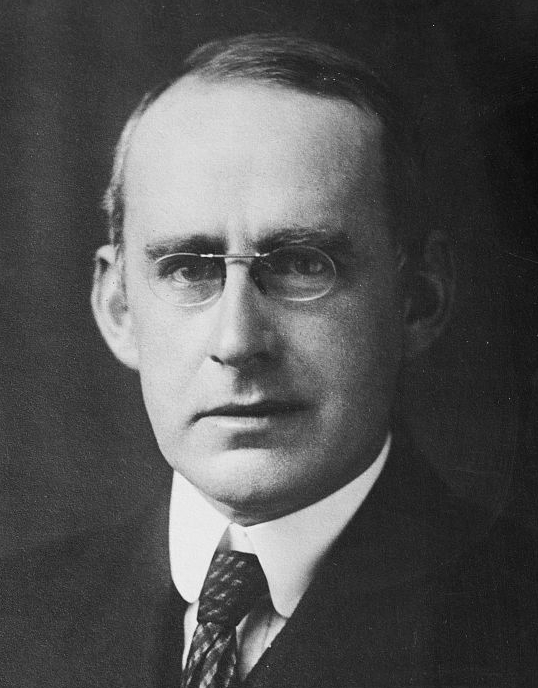
Sir Arthur Eddington led the 1919 British eclipse expedition to the island of Principe (off the west coast of Africa).
The path of totality crossed Brazil, in South America, and Principe, an island owned by Portugal, just to the north of the equator and 150 miles from the African coast. In northeastern Brazil, the city of Sobral was the best post of observation of the phenomenon and two expeditions of American and English scientists joined the Brazilians to observe the eclipse.
Their purposes were distinct. The Brazilian commission focused on studies of the solar corona, its form and shape, and performed spectroscopic analysis of its constitution. The English wanted to verify experimentally the consequences of GTR. After analysis of the eclipse results, royal astronomer Frank Dyson announced, in November 1919, that the results confirmed the theory and it was made public: Einstein was right! In fact, what provoked such commotion was precise measurement of the deviation of starlight passing close to the Sun. The value of such deviation agreed with the prediction of Einstein's GTR (1.75 arc seconds), but was almost double the value predicted by Newton’s gravitational theory (0.87 arc seconds).
This confirmation of the deviation of light is one of the most dramatic events in the history of science. It was front-page news around the globe. The London Times featured the headlines, "Revolution in science. New theory of the universe. Newtonian ideas overthrown” and The Washington Post, with "New theory of space: has no absolute dimensions, nor has time, say Savants." Although people were still mystified by his theory, his worldwide popularity increased dramatically almost overnight. Einstein was also very charismatic and became famous for his equation E=mc2. The fanfare that followed the eclipse contributed substantially to Einstein's popularity as a legendary scientist.
Map and eclipse predictions: Total Solar Eclipse of 1919 May 29
Eclipse of End of Millennium (1999 CE)
Stories about the end of the world have always frightened people throughout history. An eclipse of the Sun in the last year of the millennium would be the perfect scenario for commotion about this issue. One key ingredient for the August 11, 1999 eclipse was related to the forthcoming millennium, including predictions of catastrophes.
Map and eclipse predictions: Total Solar Eclipse of 1999 Aug 11
First Eclipses of the Third Millennium (2001 CE)
The first eclipse of the third millennium happened on January 9, 2001. This was a lunar eclipse that was total as viewed from most of Asia, Africa, Europe, and the eastern seaboard of North America. In Nigeria, the eclipse caused great consternation, and its advent was blamed on sinners. In the northeastern part of the country, there were rampages by gangs of youths. Similar destruction occurred in other towns. "The immoral acts committed in these places are responsible for this eclipse," explained one of the leaders of the riots.
Five months later, on June 21, 2001, the first total solar eclipse of the third millennium was also witnessed in Africa. As the track passed over Angola, Zambia, Zimbabwe, Mozambique, and finally the southern part of the island of Madagascar, thousands of tourists watched the spectacle, along with millions of local inhabitants. Elsewhere much wailing and gnashing of teeth accompanied what was considered the "rooting of the Sun", from which the world would never recover. The world did recover of course, quite promptly, and here we are waiting for the next meeting between the two celestial bodies in their marvelous space ballet.
Map and eclipse predictions:
Total Lunar Eclipse of 2001 Jan 09
Map and eclipse predictions:
Total Solar Eclipse of 2001 Jun 21
Eclipse seen from space (2006 CE)
The image below, obtained from the International Space Station, 230 miles above the planet, was positioned to view the umbral shadow cast by the Moon as it moved between the Sun and Earth during the solar eclipse on March 29, 2006.

The Moon's shadow passing over Earth during eclipse as viewed from the International Space Station
The astronaut image captures the umbral shadow across southern Turkey, northern Cyprus, and the Mediterranean Sea.
People living in these regions observed a total solar eclipse in which the Moon completely covered the Sun's disk.
Map and eclipse predictions: Total Solar Eclipse of 2006 Mar 29
Lunar Eclipses of History (Norma Reis)
Catalog of Lunar Eclipses of Historical Interest
Catalog of Solar Eclipses of Historical Interest
Acknowledgments
This article Solar Eclipses of History is presented on EclipseWise.com with permission from the author Norma Reis. Please contact the author (NormaReis at mec dot gov dot br) with questions or corrections.
